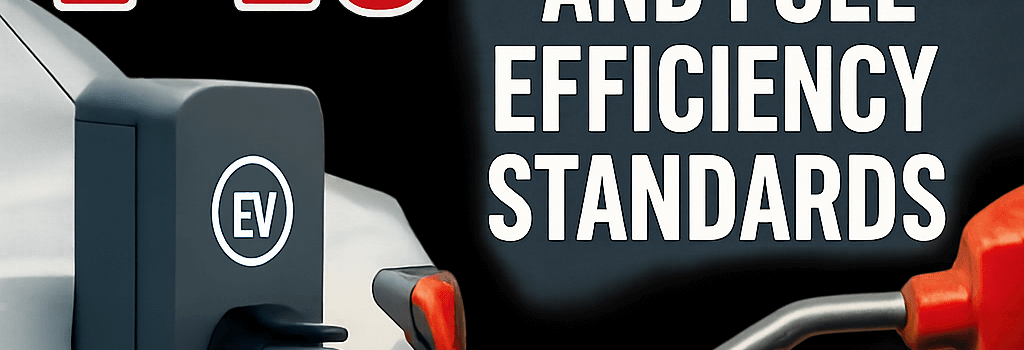GOP Rolls Back EV Incentives and Fuel Efficiency Standards

As the 2025 legislative session intensifies, Congressional Republicans and the Trump administration are spearheading a multi-front campaign to rescind key clean-vehicle rules, promising a surge in less-efficient, higher-emission vehicles on U.S. roads. The proposed “One Big Beautiful Bill Act” would dismantle Environmental Protection Agency (EPA) greenhouse-gas limits, strip Corporate Average Fuel Economy (CAFE) standards, and eliminate tax credits for electric vehicles (EVs) and hybrids. At the same time, the Senate is moving to bar EPA fines on automakers that exceed fleet emission targets, and the Department of Transportation (DOT) under Secretary Sean Duffy is reviewing—and likely rolling back—Biden-era fuel-efficiency regulations.
Legislative Push Against Emissions Standards
In early June 2025, House Republicans unveiled the One Big Beautiful Bill Act, a sprawling budget reconciliation package that would repeal:
- EPA’s 2022 Greenhouse Gas and Multi-Pollutant Emissions Standards, which require a 2026 model-year fleet average of 49 mpg (based on CAFE) and a 28 percent reduction in CO2 tailpipe emissions versus 2023 levels.
- The Corporate Average Fuel Economy rules scheduled to tighten through 2027, including manufacturer credits for EVs and hybrids.
- IRS clean-vehicle tax credits: $7,500 for new EVs and fuel-cell vehicles, $4,000 for certain used EVs, and $7,500 for commercial LEV (low-emission vehicle) leases.
By repealing those rules, the bill would remove regulatory incentives for automakers to deploy advanced powertrains—such as plug-in hybrids with 40+ mile electric range or battery packs exceeding 70 kWh. In effect, EPA removal of tailpipe CO2 limits would allow internal-combustion engine (ICE) vehicles with displacement up to 6.0 L and single-digit fuel-economy ratings (12–15 mpg in city driving) back on the mainstream market.
Technical Impact on Emissions Control Hardware
Current EPA regulations mandate selective catalytic reduction (SCR) and diesel particulate filters (DPF) on modern diesels, plus gasoline particulate filters on turbocharged engines. Rolling back emissions standards risks eliminating onboard after-treatment hardware—urea injection nozzles, close-coupled catalysts, NOx adsorbers—and could see a return to carbureted or port-injection ICE architectures that lack precise closed‐loop lambda control. Without strict OBD-II monitoring, automakers would no longer be compelled to certify vehicles under real driving emissions (RDE) protocols.
Senate Proposal to Eliminate Fines
On the Senate floor, Republicans introduced legislation barring the EPA from levying fines on automakers that exceed fleet averages. Under existing CAFE penalty structures, manufacturers pay roughly $5.50 per 0.1 mpg under the target, with fines in the hundreds of millions annually. Eliminating these penalties would not only save OEMs billions but also remove any financial disincentive against downgrading emissions control systems.
DOT’s Review of Fuel Efficiency Regulations
Secretary of Transportation Sean Duffy has initiated a formal Notice of Proposed Rulemaking to revisit Biden-era fuel-efficiency standards. In today’s decision, the DOT asserted that including EVs in CAFE compliance “artificially inflates” fleet mpg and “misallocates” credits. By decoupling EV credits—which currently can reduce an automaker’s required mpg by up to 10 mpg—the proposal effectively mandates lower corporate targets, emboldening ICE-only powertrain strategies.
State-Level Waivers and California Standards Under Threat
California’s Clean Air Act waiver (Section 209) has long allowed the California Air Resources Board (CARB) to set stricter emissions and ZEV mandates. The GOP bill would rescind that waiver, prohibiting any state—Arizona, Colorado, or New York included—from adopting more stringent standards than the federal baseline. That move eliminates another vital source of ZEV credit trading, potentially undermining Tesla’s battleground strategy of banked credits sales to legacy automakers.
Expert Opinions and Industry Reactions
“Repealing these standards will delay the auto-sector’s transition to electrification by up to a decade,” warns Dr. Isabella Nguyen, senior transportation analyst at the Union of Concerned Scientists. “It risks undermining investments in battery cell gigafactories and reducing economies of scale critical for bringing down pack costs below $100/kWh.”
“This is a direct attack on U.S. competitiveness,” says James Murtha, VP of regulatory affairs at the Alliance for Automotive Innovation. “Automakers have planned capacity expansions for electrified powertrains based on current rules. Rolling them back imposes tremendous commercial uncertainty.”
Technology Implications for OEMs and Consumers
In the short term, U.S. OEMs could ramp up production of high-profit, low-efficiency light trucks with V8 powertrains. However, supply chains for advanced catalytic materials—platinum group metals, SCR substrates—could contract, eroding expertise. Consumers may see lower sticker prices on ICE vehicles, but face higher long‐term fuel costs: a drop from 49 mpg to an average of 30 mpg translates to an extra $800–$1,200 per year in gasoline at $3.50/gallon.
Long-Term Consequences for Climate Targets
The U.S. transportation sector currently accounts for 29 percent of national greenhouse‐gas emissions. Under the Paris Accord, the U.S. pledged a 50–52 percent reduction below 2005 levels by 2030. Repealing tailpipe CO2 limits and EV credits throws those targets out the window: an ICE vehicle emits ~200 g CO2/mile, whereas an EV on the current U.S. grid averages ~120 g CO2/mile lifecycle. A reversal in policy could add 100 million metric tons of CO2 annually over the next five years.
Looking Ahead: Navigating Regulatory Uncertainty
With the political pendulum swinging, automakers and suppliers must hedge their technology roadmaps. Many have already invested tens of billions in EV platforms: General Motors’ Ultium, Ford’s eMach, Stellantis’ STLA. The potential rollback underscores the need for modular powertrain architectures that can switch between ICE, hybrid and battery-electric modules with minimal retooling.
The coming weeks will determine whether the U.S. reaffirms its climate commitments or cedes the EV market leadership to China and Europe.